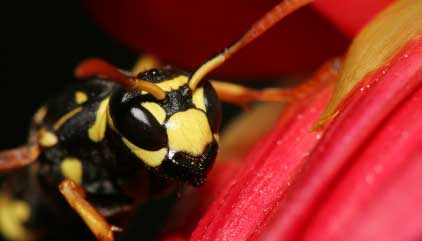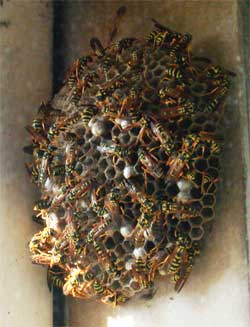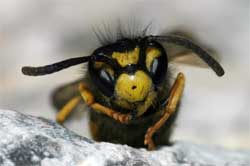|
Wasp is the common name applied to most species of
hymenopteran insects, except bees and ants. Insects known as wasps
include the sawflies, the parasitic wasps, and the stinging wasps,
which are the best known. About 75,000 species of wasps have been
identified, most of them parasitic.
|
|

Wasps are characterized by two pairs of membranous wings and an
ovipositor (tube for laying eggs) that may be modified in various
ways. In some species one sex may be wingless. Most stinging wasps
are predators or scavengers; their ovipositors may be modified to
inject venom used for killing prey or for defense.


No place to call home: Unlike social wasps, sawflies and parasitic wasps are free-living;
that is, they do not build nests. After depositing their eggs on
a host plant or animal, the adult wasps fly off in search of food
for themselves or more hosts for their larvae. The eggs are left
to develop and hatch on their own. Stinging wasps tend to live in
hives and societies similar to bees and ants.
 Various homes: The stinging wasps rely on a nest from which they conduct many
of their activities, especially rearing young. Wasp nests may be
as simple as a straight burrow in the ground, while others, such
as those of mud daubers and potter wasps, are above ground, constructed
of mud cavities attached to twigs, rocks, or human structures. The
simplest mud nests contain only one or a few larval cells and are
not used by the adults. Other mud nests contain many cells arranged
side by side. Among the most intricate nests are those made of paper
fibers collected from dry wood and bark and mixed with the wasps'
saliva. The vespoid wasps (yellow jackets, hornets, and paper wasps)
build nests of this type. In each paper-fiber nest there are one
or more combs, or densely packed arrays of cells for larva. The
adults may congregate on the combs, and some nests have an outer
cover, forming a protective refuge for the whole colony. This is
the familiar "hornet's nest" that may house hundreds or
thousands of individuals. Various homes: The stinging wasps rely on a nest from which they conduct many
of their activities, especially rearing young. Wasp nests may be
as simple as a straight burrow in the ground, while others, such
as those of mud daubers and potter wasps, are above ground, constructed
of mud cavities attached to twigs, rocks, or human structures. The
simplest mud nests contain only one or a few larval cells and are
not used by the adults. Other mud nests contain many cells arranged
side by side. Among the most intricate nests are those made of paper
fibers collected from dry wood and bark and mixed with the wasps'
saliva. The vespoid wasps (yellow jackets, hornets, and paper wasps)
build nests of this type. In each paper-fiber nest there are one
or more combs, or densely packed arrays of cells for larva. The
adults may congregate on the combs, and some nests have an outer
cover, forming a protective refuge for the whole colony. This is
the familiar "hornet's nest" that may house hundreds or
thousands of individuals.
An important link in the chain: Wasps are highly important to ecosystems. Sawflies consume vegetation
and so limit plant growth. Most other wasps are either parasitic
or predaceous and therefore play a vital role in limiting the populations
of thousands of other insect species. All wasps are eaten by other
species, thereby providing many links in the food web. Many parasitic
wasps have been cultured and used in the biological control of agricultural
pests. Although a few of the stinging wasps are considered nuisances,
they also provide benefits. Yellow jackets and paper wasps, for
example, prey on caterpillars and other larvae that can destroy
crops. Some wasps feed on flower nectar and play a role in pollination.
 Dangerous females: All female stinging wasps can defend themselves and their nests
by using their ovipositor to inject venom. Males do not have a stinger.
No species will attack a human except in defense. If the colonies
of some yellow-jacket and hornet species are disturbed, they may
respond by releasing more than 100 defending wasps, each capable
of delivering several stings. The nests of these species should
be left alone or removed professionally if they are considered a
nuisance. Wasp venom contains factors that release histamine, which
dissolves red blood cells. Most people can survive many stings,
responding with only temporary pain and swelling, but to hyperallergic
individuals--about 1 percent of the population--a single wasp sting
can be fatal. Dangerous females: All female stinging wasps can defend themselves and their nests
by using their ovipositor to inject venom. Males do not have a stinger.
No species will attack a human except in defense. If the colonies
of some yellow-jacket and hornet species are disturbed, they may
respond by releasing more than 100 defending wasps, each capable
of delivering several stings. The nests of these species should
be left alone or removed professionally if they are considered a
nuisance. Wasp venom contains factors that release histamine, which
dissolves red blood cells. Most people can survive many stings,
responding with only temporary pain and swelling, but to hyperallergic
individuals--about 1 percent of the population--a single wasp sting
can be fatal.
All text is available under the terms
of the GNU Free Documentation License
|